I happened to be in Kyoto this November from the 27th until the 30th to attend the 2006 International Conference on Asian Digital Libraries. One of the presentations was a brief introduction to the recently opened Kyoto International Manga Museum, which I decided to visit in a few hours I had prior to returning to Tokyo. I’ve put together a few notes on the museum that might be of interest to foreigners who might like to visit. I myself have a bit of an interest in Manga, and it was recommended by Maureen Donovan, who manages Ohio State’s Manga Collection.
Location
The museum is located conveniently at the intersection of Karasuma and Koike streets, right near the Tozai and Karasuma subway line stops at “Karasuma Koike station”. It is about a one or two minute walk, although finding the proper direction to walk in can be a bit tough. If you take exit 2 from the subway station though, you should just have to keep going straight (although on the discount coupon I received, they said exit 5, while their website says exit 2. I don’t know which is correct, but you can try each road, just walk down it half a block. You can see the museum shortly.) You can also walk from Nijyou Castle easily in about ten minutes, which is what I did.
Museum Architecture / Design
The museum itself is quite new; it opened on Friday, November 24th, 2006, less than a week before I visited it. The museum itself was converted from the old Ryuike (I assume, my name reading isn’t always the best in the world) elementary school, and is on a beautiful, large space. I was really impressed with the size of the museum; it has a basement for manga storage, primarily reading and workshop spaces on the first floor, exhibition and event spaces on the second floor, and research space and further manga storage on the third floor. This is not a small-scale effort, and having seen my share of museums when I lived in New York (and now Tokyo) this is a very nice space. Since it just opened it is very clean, and well designed.
The main museum consists of two buildings, connected on the first floors, and with a bridge on the second floor. It retains a feel somehow of a Japanese school, and one of the first exhibit rooms on the second floor is dedicated to the history of the Ryuuike school, detailing how they drew a manga about it from interviews with people that went there.
It has a light and airy feel in some spaces also, where the area has been opened up. The beautiful courtyard is very surprising too; it is rare to see such wide open spaces in the middle of Japan’s cities. This floor map might help you visualize the place, but it is only in Japanese. A brief description would be: 3F Research Zone. 2F Gallery Zone (the 4 main galleries are here.) 1F Workshop Zone, Shop Corner, Cafe. BF Material storage zone.
First Floor
Entry costs 500 yen for an adult, but you are able to re-enter on the say day if you retain your ticket stub. This is actually a very reasonable fee, especially if you are interested in reading manga. They have lots of manga to read, you are free to take manga down from the shelves living the hallways and relax on one of the benches or tables to read. When I was there, from about 1pm until 4pm on a Thursday afternoon, there were at least thirty people doing just that. Children have a reduced entry fee.
Upon entering, you are greeted with the ticket-selling machines, and then a reception desk. The gift shop is also right at the entrance, and accessible without buying a ticket (I assume.) The shop is very small, but has some interesting things, particularly if you like things for your cell-phone. It looks like they are also selling iconic manga series as well, and they had a super-cute Atom coffee mug that I was sorely tempted to buy. (I didn’t though, as I prefer hand-made personalized ceramics for my hot-chocolate drinking needs. Since she makes stuff with rabbits and robots on it, that is good enough for me. And dinosaurs.) After passing the information desk, where they take your ticket and give you a “Manga Passport” with a map of the place, there is an area for workshops. This area was primarily used to read manga though, since the workshops had ended for the day. As with most of the wall space in the museum, there were shelves along the sides of the room, and plenty of manga to pick up and read.
On the first floor, there is a very cute library area designed especially for children and their parents, with some toys to play with, a floor that has a shaped floor like valleys and ponds, and many children’s books for the parents and children to read together. They are very strict about it being only for children or their guardians though, and I was (politely) told that I can’t not enter. As with many places in Japan, you have to take off your shoes. On the map this is the freaky green room with a little blue pond in it – of course, those are just the floor colorings, but it does have the contoured floor. It looked like lots of fun, and even through I protested that I thought that “those books are the only ones I can read!” (not true, but worth a shot) the staff didn’t let me in. It is ok though because, they were, after all, only “thinking of the children”. I assume.
100 People’s Welcome Cards
I forget exactly what they called this, and I can’t find any information about it on the website so I’ll go from memory. From the first floor to the second floor along the hallways they put up framed postcards they solicited from famous manga authors. Each card is a little picture commemorating the opening of the museum. In all cases the picture was of some sort of geisha, so I think they had instructions about that, or everyone thought “manga? Kyoto? Geisha!”, which is also likely. The only one that I recognized was from the author of Anpanman, but I don’t really know much about historical manga. There was no card by Shirow Miwa, who is easily my favorite author. It was interesting seeing all the styles, and trying to find any authors that I might recognize. This is a temporary thing though, so I don’t know how long it will remain.
There are two conference rooms and a seminar room on the first floor, but I am not sure under what conditions they can be used. There is also a large screening room for anime or movies I suppose. They take a fairly broad view of the term “manga”, which I disagree with, and also have some multimedia in the museum. By the way, down the hallways near the children’s library you can find Fujisawa Tooru’s “Great Teacher Onidzuka”, a favorite series of mine. Near the end of my visit, I read about half of volume 20, which is where I last let off before TokyoPop licensed the series.
Second Floor
The second floor has two more study rooms, one of which was being used for a Kami Shibai show, but I’ll talk about that later. The first room detailed the history of the Ryuuike school, and had a manga drawn up based on interviews with people that attended the school. Nearby was a “Future of Manga Research” room, aimed at a younger audience. It had a bunch of computers running flash games that let you design character by clicking on changing heads, bodies, etc. There was also a kind of interactive manga where you had to click at the right time to punch, and so on. One machine was running a program that animated a character’s mouth as you spoke into a microphone. I’ve seen much more impressive things done with microphones and computers, for example ATR’s impressive automatic speach-to-speach translation software. I’ve also done some work on my own looking at how to use computers for manga translation. Still, I think kids would have a lot of fun with the programs they had there.
A second small room had an exhibit on the World’s manga. I think this is a permanent collection, since the main exhibit is “The World’s Manga”. One really interesting thing is that they had a copy of MegaTokyo number 2, which for some reason just struck me as totally hilarious. That’s really about all I have to say about that.
One event that I found very interesting was the Kami Shibai exhibition. They had a practicing “Kami Shibai” (translates to “Paper Play” but he specifically told me that when I talk about Kami Shibai, like Kabuki, it should not be translated literally) who put on a play for us. Of course, back in the 50s before TVs were everywhere, they used to have guys who would ride up on their bikes, and put on a play / slide show type thing with the pieces of paper you see up on top. They would talk and slide the things out. Also, it seems like they sold candy and things to the kids. In between the first and second act of our play (usually done over two days, where they say “And come back tomorrow to see what happens!”) he did a quiz. One of the questions for the series of “what ken (place / district) is this?” was “What rolls around and around?” The answer was “Oita ken” because it hurts… Another was “In what Ken does everyone carry guns?” I thought about it and answered “Kiken” (dangerous) and he kind of laughed a bit. The answer was Tottori-ken (because tottori mean to “catch a bird”, in other words, shoot a bird, so you need a gun) but he said that one time when he did that quiz a young kid in kindergarten also answered “Kiken”, and he thought that was great because we’ve all forgotten the most important things about life, and young kids are still innocennt.
I just thought “damn, I’m no smarter than a kid in kindergarten”, but he did give me a “mizu-ami” candy and a little toy ring for answering (incorrectly!) The mizu-ami candy wasn’t bad. It was some senbei (rice crackers) put onto a stick with this sweet gummy stuff, and he made rabbit ears and drew on the sembei with a surprisingly salty sauce (seemed like an okonomiyaki sauce) that really didn’t seem to suit candy, but worked out ok in the end.
Anyway, he was a really great guy, and it was totally interesting.
The main exhibition gallery is across the bridge, and is showing some manga from other countries, and then a large retrospective on Japanese manga. It was really interesting to see some of the really old manga, going back to the 1800s, and other very famous manga, like the first issue of “Ribbon” and things like that. The exhibit was quite large, and in the Australian section even mentioned the Lost in Scanlation (I relly hate the term “scanlation”) fan translation team out of Monash University. Another of the exhibition rooms had an interesting display of single-panel comics from around the world, mostly focusing on global warming.
Third Floor
The third floor was still not quite complete when I saw it, but mainly consists of more manga.
Basement
I didn’t venture into the basement. I didn’t want to be eaten by a Grue.
Café
On the way out I stopped by the cafe. It is really a separate building with its own external entrance, which is too bad because you can’t bring manga into the cafe (I didn’t try, maybe you could, but nobody in there had any manga.) Still, a nice cafe with very friendly staff. They seemed shocked to see a foreigner and were happy to chat.
Final Thoughts
I was quite surprised that the manga museum was really not a foreigner-friendly place. Most of the larger tourist destinations are very foreigner friendly, and have at least English plaques with some explanation on them. There was very little English (aside from the manga exhibits from English-speaking countries) in the museum, and I think someone who doesn’t at least read kanji comfortably would have a tough time. In practice though, this probably isn’t a problem because anyone that is going to go all the way to Kyoto for a manga museum probably has a good enough foundation in the language that they can at least read manga. Still, I think they would attract a lot of foreigners if they could set up the exhibits to have some English attached explaining them. All of the explanations were in Japanese.
I really was surprised by this because one of the people on staff at the library, Matthew Alen Thorn, gave a talk at the International Conference on Asian Digital Libraries about the Manga Museum, and I would have thought that with a foreigner on-board, they would have tried to think about the wider international appeal. Perhaps that will come later, and the museum is still in its opening phases, and has not yet rolled out any of the web-based digital library content that they talked about. They did have some nice digital content, particularly scans of very old manga that you could view on PCs at the exhibit. The software was quite poor, but the data is there. I’m looking forward to seeing what happens with this museum.


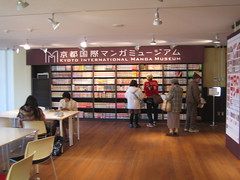
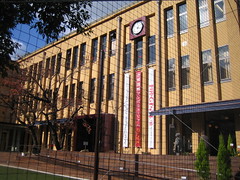
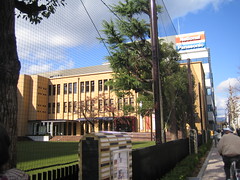
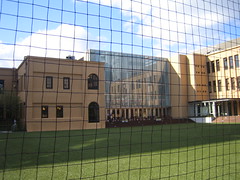
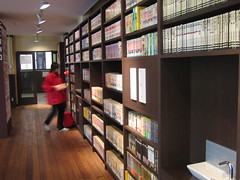
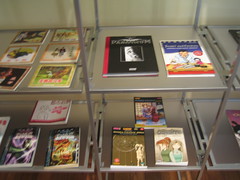
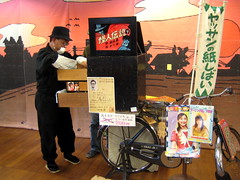
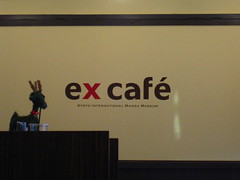
Leave a Reply